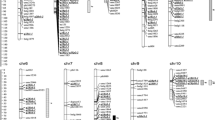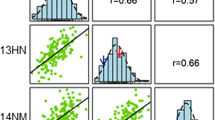Abstract
A study was initiated to determine the number, chromosomal location, and magnitude of effect of QTL (quantitative trait loci or locus depending on context) controlling protein and starch concentration in the maize (Zea mays L.) kernel. Restriction fragment length polymorphism (RFLP) analysis was performed on 100 F3 families derived from a cross of two strains, Illinois High Protein (IHP), X Illinois Low Protein (ILP), which had been divergently selected for protein concentration for 76 generations as part of the Illinois Long Term Selection Experiment. These families were analyzed for kernel protein and starch in replicated field trials during 1990 and 1991. A series of 90 genomic and cDNA clones distributed throughout the maize genome were chosen for their ability to detect RFLP between IHP and ILP. These clones were hybridized with DNA extracted from the 100 F3 families, revealing 100 polymorphic loci. Single factor analysis of variance revealed significant QTL associations of many loci with both protein and starch concentration (P < 0.05 level). Twenty-two loci distributed on 10 chromosome arms were significantly associated with protein concentration, 19 loci on 9 chromosome arms were significantly associated with starch concentration. Sixteen of these loci were significant for both protein and starch concentration. Clusters of 3 or more significant loci were detected on chromosome arms 3L, 5S, and 7L for protein concentration, suggesting the presence of QTL with large effects at these locations. A QTL with large additive effects on protein and starch concentration was detected on chromosome arm 3L. RFLP alleles at this QTL were found to be linked with RFLP alleles at the Shrunken-2 (Sh2) locus, a structural gene encoding the major subunit of the starch synthetic enzyme ADP-glucose pyrophosphorylase. A multiple linear regression model consisting of 6 significant RFLP loci on different chromosomes explained over 64 % of the total variation for kernel protein concentration. Similar results were detected for starch concentration. Thus, several chromosomal regions with large effects may be responsible for a significant portion of the changes in kernel protein and starch concentration in the Illinois Long Term Selection Experiment.
Similar content being viewed by others
References
Bae JM, Giroux M, Hannah LC (1990) Cloning and characterization of the Brittle-2 gene of maize. Maydica 35:317–322
Bennett D (1975) The T-locus of the mouse. Cell 6:441–454
Bhave MR, Lawrence S, Barton C, Hannah LC (1990) Identification and moelcular characterization of Shrunken-2 cDNA clones of maize. Plant Cell 2:581–588
Chourey PS, Nelson OE (1976) The enzymatic deficiency conditioned by the shrunken-1 mutations in maize. Biochem Genet 14:1041–1055
Coe E (1992) Gene list and working maps. Maize Genet Coop Newsl 66:127–159
Comstock RE, Robinson HF (1948) Estimates of average dominance of genes, p. 494–516. In: Gowen JW (ed) Heterosis. Iowa State College Press, Ames, Iowa
Dickinson DB, Preiss J (1969) ADP-glucose pyrophosphorylase from maize endosperm. Arch Biochem Biophys 130:119–128
Dudley JW (1977) Seventy-six generations of selection for oil and protein percentage in maize. In: Pollack E, Kempthorne O, Bailey TB Jr (eds) Proc Int Conf Quant Genet. Iowa State University Press, Ames, Iowa, pp 459–474
Dudley JW, Lambert RJ (1992) Ninety generations of selection for oil and protein in maize. Maydica 37:1–7
Edwards MD, Stuber CW, Wendel JF (1987) Molecular-marker-facilitated investigations of quantitative trait loci in maize. 1. Numbers, genomic distribution and types of gene action. Genetics 116:113–125
Edwards MD, Helentjaris T, Wright S, Stuber CW (1992) Molecular-marker-facilitated investigation of quantitative trait loci in maize. 4. Analysis based on genome saturation with isozyme and restriction fragment length polymorphism markers. Theor Appl Genet 83:765–774
Feinberg A, Vogelstein B (1983) A technique for radiolabeling DNA restriction endonuclease fragments to high specific activity. Anal Biochem 132:6–13
Glover DV (1988) Corn protein and starch-genetics, breeding, and value in foods and feeds. Am Seed Trade Assoc Proc 43:106–130
Hoisington D (1991) University of Missouri RFLP procedures manual. University of Missouri, Columbia, Mo.
Hopkins CG (1899) Improvement in the chemical composition of the corn kernel. Ill Agric Exp Stn Bull 55:205–240
Hymowitz T, Dudley JW, Collins FI, Brown CM (1974) Estimations of protein and oil concentration in corn, soybean, and oat seed by near-infrared light reflectance. Crop Sci 14:167–170
Keim P, Diers BW, Shoemaker RC (1990) Genetic analysis of soybean hard seededness with molecular markers. Theor Appl Genet 79:465–469
Lander ES, Botstein D (1989) Mapping Mendelian factors underlying quantitative traits using RFLP linkage maps. Genetics 121:185–199
Lee M (1991) Iowa State RFLP procedures manual. Iowa State University Press, Ames, Iowa
Mather K, Jinks J (1977) Introduction to biometrical genetics. Cornell University press, New York
Mertz ET, Bates LS, Nelson OE (1964) Mutant gene that changes protein composition and increases lysine content in maize endosperm. Science 145:279–280
Osborn TC, Alexander DC, Fobes JF (1987) Identification of restriction fragment length polymorphisms linked to genes controlling soluble solids content in tomato fruit. Theor Appl Genet 73:350–356
Paterson AH, Lander ES, Hewitt JD, Peterson S, Lincoln SE, Tanksley SD (1988) Resolution of quantitative traits into Mendelian factors, using a complete linkage map of restriction fragment length polymorphisms. Nature 355:721–726
Pontecorvo G (1950) New fields in the biochemical genetics of micro-organisms. Biochem Soc Symp Vol 4. Cambridge, England, pp 40–50
Preiss J (1982) Regulation of the biosynthesis and degradation of starch. Annu Rev Plant Physiol 33:431–454
Reiter RS, Coors JG, Sussman MR, Gabelman WH (1991) Genetic analysis of tolerance to low-phosphorous stress in maize using restriction fragment length polymorphisms. Theor Appl Genet 82:561–568
Robertson DS (1985) A possible technique for isolating genic DNA for quantitative traits in plants. J Theor Biol 117:1–10
Sambrook J, Fritsch EF, Maniatis T (1989) Molecular cloning: a laboratory manual, 2nd edn. Cold Spring Harbor Laboratory Press, Cold Spring Harbor, N.Y.
Saghai-Maroof MA, Soliman KM, Jorgensen RA, Allard RW (1984) Ribosomal DNA spacer-length polymorphisms in barley: Mendelian inheritance, chromosomal location, and population dynamics. Proc Natl Acad Sci USA 81:8014–8018
Schmidt RJ, Burr FA, Auckermann MJ, Burr B (1990) Maize regulatory gene opaque-2 encodes a protein with a “leucinezipper” motif that binds to zein DNA. Proc Natl Acad Sci 87:46–50
Sheldon E, Ferl R, Federoff N, Hannah LC (1983) Isolation and analysis of a genomic clone encoding sucrose synthetase in maize: evidence for two introns in sh. Mol Gen Genet 190:421–426
Sughroue and Rocheford (1993) Restriction fragment length polymorphism among Illinois long term selection strains. Theor Appl Genet (in press)
Thompson JN (1975) Quantitative variation and gene number. Nature 258:665–668
Tsai CY, Nelson OE (1966) Starch deficient maize mutants lacking adenosine diphosphate glucose pyrophosphorylase activity. Science 151:341–343
Young ND, Zamir D, Ganal MW, Tanksley SD (1988) Use of isogenic lines and simultaneous probing to identify DNA markers tightly linked to the Tm-2a gene in tomato. Genetics 120:579–585
Author information
Authors and Affiliations
Additional information
Communicated by A. R. Hallauer
Rights and permissions
About this article
Cite this article
Goldman, I.L., Rocheford, T.R. & Dudley, J.W. Quantitative trait loci influencing protein and starch concentration in the Illinois Long Term Selection maize strains. Theoret. Appl. Genetics 87, 217–224 (1993). https://doi.org/10.1007/BF00223767
Received:
Accepted:
Issue Date:
DOI: https://doi.org/10.1007/BF00223767




